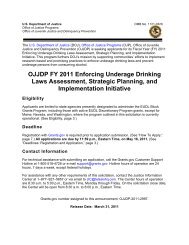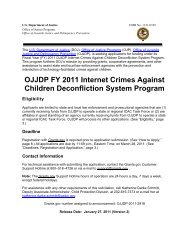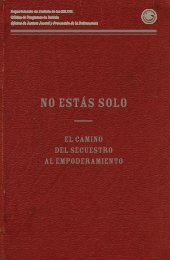Promising Strategies To Reduce Gun Violence - Office of Juvenile ...
Promising Strategies To Reduce Gun Violence - Office of Juvenile ...
Promising Strategies To Reduce Gun Violence - Office of Juvenile ...
You also want an ePaper? Increase the reach of your titles
YUMPU automatically turns print PDFs into web optimized ePapers that Google loves.
Pr<strong>of</strong>ile No. 1 (continued)<br />
Comprehensive Communities<br />
Program<br />
By the spring <strong>of</strong> 1995, the Mayor’s Coordinating<br />
Council on Criminal Justice had received a<br />
grant from the Bureau <strong>of</strong> Justice Assistance<br />
to become 1 <strong>of</strong> 16 national sites participating<br />
in the Comprehensive Communities Program<br />
(CCP). The work being done by CLC and<br />
CPHA was well known, and the mayor’s<br />
<strong>of</strong>fice asked the groups to expand and implement<br />
Baltimore’s CCP initiative in several<br />
core communities: Boyd Booth, Carrollton<br />
Ridge, Fayette Street, Franklin Square,<br />
Harlem Park, and New Southwest. Dozens<br />
<strong>of</strong> other areas were identified as apprentice<br />
sites that would receive more limited<br />
assistance (e.g., training and the services <strong>of</strong><br />
a pro bono attorney) to develop their own<br />
comprehensive crime prevention strategies.<br />
Building community capacity is absolutely<br />
key. You have to begin by identifying<br />
the people and institutions in the local<br />
neighborhoods who have a stake in the<br />
community and really want to address the<br />
neighborhood’s problems. And then you<br />
have to give them the resources that they<br />
need to be successful—and that’s where<br />
the Mayor’s Coordinating Council on<br />
Criminal Justice comes in. We are able to<br />
bring together all the key agencies—law<br />
enforcement, housing, community<br />
organizers, youth, legal advisers—and<br />
marshall their resources in a focused way<br />
to have the biggest impact on solving the<br />
neighborhood’s problems. We then build<br />
the relationships between these groups to<br />
sustain the effort over the long haul.<br />
—Betsi Griffith<br />
Baltimore, MD, Mayor’s Coordinating<br />
Council on Criminal Justice<br />
The first-year planning grant allowed the<br />
partners to establish a solid foundation for<br />
the initiative by recruiting and training<br />
local leadership, working with residents to<br />
identify priority problems, mapping out<br />
strategies, and establishing relationships<br />
with key groups such as law enforcement<br />
and nearby schools. The nonpr<strong>of</strong>it Neighborhood<br />
Design Center was brought on as a<br />
partner to help residents reduce drug<br />
dealing and other criminal activities by<br />
changing the physical environment. The<br />
center’s approach, entitled Crime Prevention<br />
Through Environmental Design (CPTED),<br />
encourages residents to reclaim public<br />
spaces such as parks and playgrounds that<br />
have been taken over by drug dealers,<br />
prostitutes, and others because they are<br />
poorly maintained or are not used by lawabiding<br />
citizens. Typical CPTED activities<br />
include the establishment <strong>of</strong> community<br />
gardens on vacant lots or staking “ownership”<br />
<strong>of</strong> street corners by having vigils.<br />
Full implementation <strong>of</strong> Baltimore’s CCP<br />
initiative began in 1995. Implementation<br />
funding was provided not only through a<br />
Bureau <strong>of</strong> Justice Assistance discretionary<br />
grant, but also through grants from the<br />
Merck Foundation, the Abell Foundation,<br />
two Federal block grant programs (Byrne<br />
Memorial Block Grant Funds and Local<br />
Law Enforcement Block Grants), and inkind<br />
contributions from the city’s Department<br />
<strong>of</strong> Public Works and the police. The<br />
CCP initiative has a number <strong>of</strong> critical<br />
program elements, which follow.<br />
Community-based anticrime<br />
strategies<br />
CCP sites use six strategies to reduce crime<br />
in target areas:<br />
◆ Denying the drug trade and other criminal<br />
activities the space in which to operate by<br />
using CPTED and other measures to turn<br />
these spaces into viable community assets.<br />
20 <strong>Promising</strong> <strong>Strategies</strong> <strong>To</strong> <strong>Reduce</strong> <strong>Gun</strong> <strong>Violence</strong>






![Chapter 5 [PDF] - Office of Juvenile Justice and Delinquency ...](https://img.yumpu.com/46584340/1/190x245/chapter-5-pdf-office-of-juvenile-justice-and-delinquency-.jpg?quality=85)









